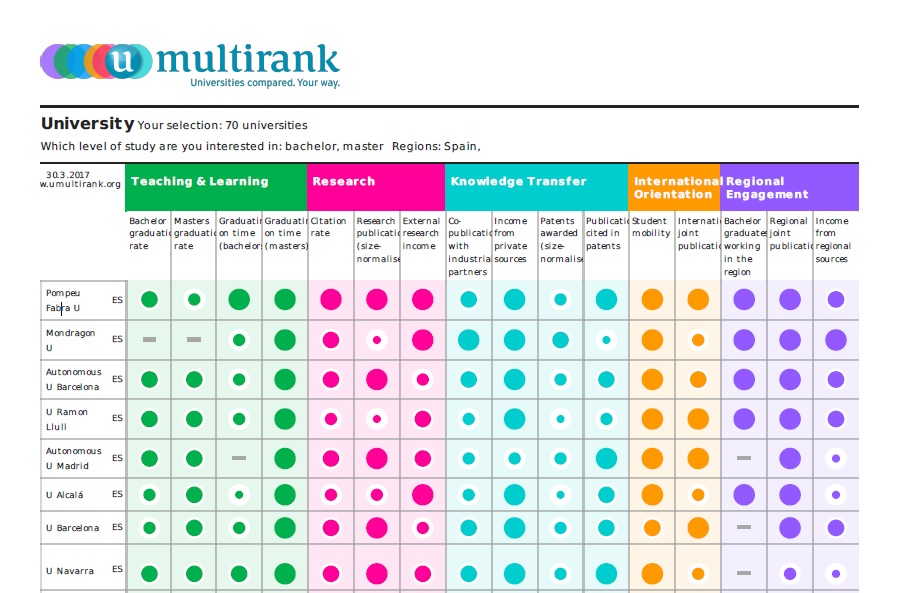Pompeu Fabra University, the first University in Spain, according to the EU’s U-Multirank
UPF obtains the maximum score (A, very good) in eleven of the sixteen indicators included in the ranking, and stands out mainly for its teaching, research, internationalization and regional engagement.
Pompeu Fabra University holds first position in the ranking of universities in the Spanish State (maintaining its position of last year), in the fourth edition of U-Multirank, a multi-dimensional classification drawn up by the European Union, which has become the world’s most important tool for comparing universities.
It is the result of a search carried out with a wide range of criteria -universities in Spain that teach undergraduate, master’s and doctoral degrees-and without modifying the indicators that, by default, are already in the tool. The second Spanish institution that appears in the list (which includes 70 Spanish centres) is the University of Mondragon; third, the Autonomous University of Barcelona, and fourth, Ramon Llull University.

U-Multirank, created in 2014 with the aim of moving away from the “closed” rankings and ratings of higher education centres, is based on data sent by the universities themselves and others obtained directly by the European Union.
So, bearing in mind that there are centres that have not provided data in several of the areas requested, UPF also appears in first place on a European scale (including both EU and non-EU countries), out of a total of 814 universities. The first five positions in Europe are completed by the Technical of Denmark, Erasmus of Rotterdam, Newcastle (United Kingdom) and Telecom ParisTech (France).
UPF’s scores in the ranking
The ranking splits the scores obtained by the universities into A (very good), B (good), C (above average), D (below average) and E (weak). Of the sixteen listed indicators, UPF gets an A in eleven (graduating on time (bachelor’s degrees), graduating on time (master’s degrees), citation rate, research publications, external research income, income from private resources, publications cited in patents, student mobility, joint international publications, graduates working in the region, and regional co-publications).
In three cases, it gets a B (graduation rate long first degree, co-publications with industrial partners and income from regional sources) and in two cases, a C (MA graduation rate and patents awarded). In the graphics, the dash (-) means that the data are not available, basically because the institution has not sent the information requested, and the X means that the information available to the ranking is not applicable because it does not fulfil the requirements.
A tool that allows performing customized user searches
U-Multirank is a tool that allows students, universities, businesses, policy makers and governments to make well-founded comparisons about universities from all over the world. It is special in that it allows the user to choose what parameters to include in making their choice. So, for example, you can select universities according to their size (small, medium, large); the type of degrees they teach (bachelor’s, master’s, doctorates); the revenue they devote to research; their origin (filtered by continent, country or region), etc.
The user can choose from the different indicators and the tool performs the search automatically only among the universities that meet these requirements. Subsequently, the application evaluates the activity of the chosen institutions based on five dimensions (teaching, research, knowledge transfer, internationalization and regional engagement), among which are the different indicators.
Moreover, the tool allows consulting the results in different ways. The “students” option allows locating a university in accordance with the interests of the user; the “compare” option allows you to view the comparison of two or more universities and, finally, the “at a glance” option allows you to consult the profile of a university (UPF profile).
The fourth edition of U-Multirank is the most comprehensive since it was launched in 2014. It includes a total of some 1,500 institutions from around the world (almost double the number of the first edition, and more than 150 additional ones compared to last year). The number of countries covered has risen from 70 in the first edition to 99 in the current edition (in the 2016 edition, there were 93), with 3,284 faculties and centres and 10,526 study programmes.
